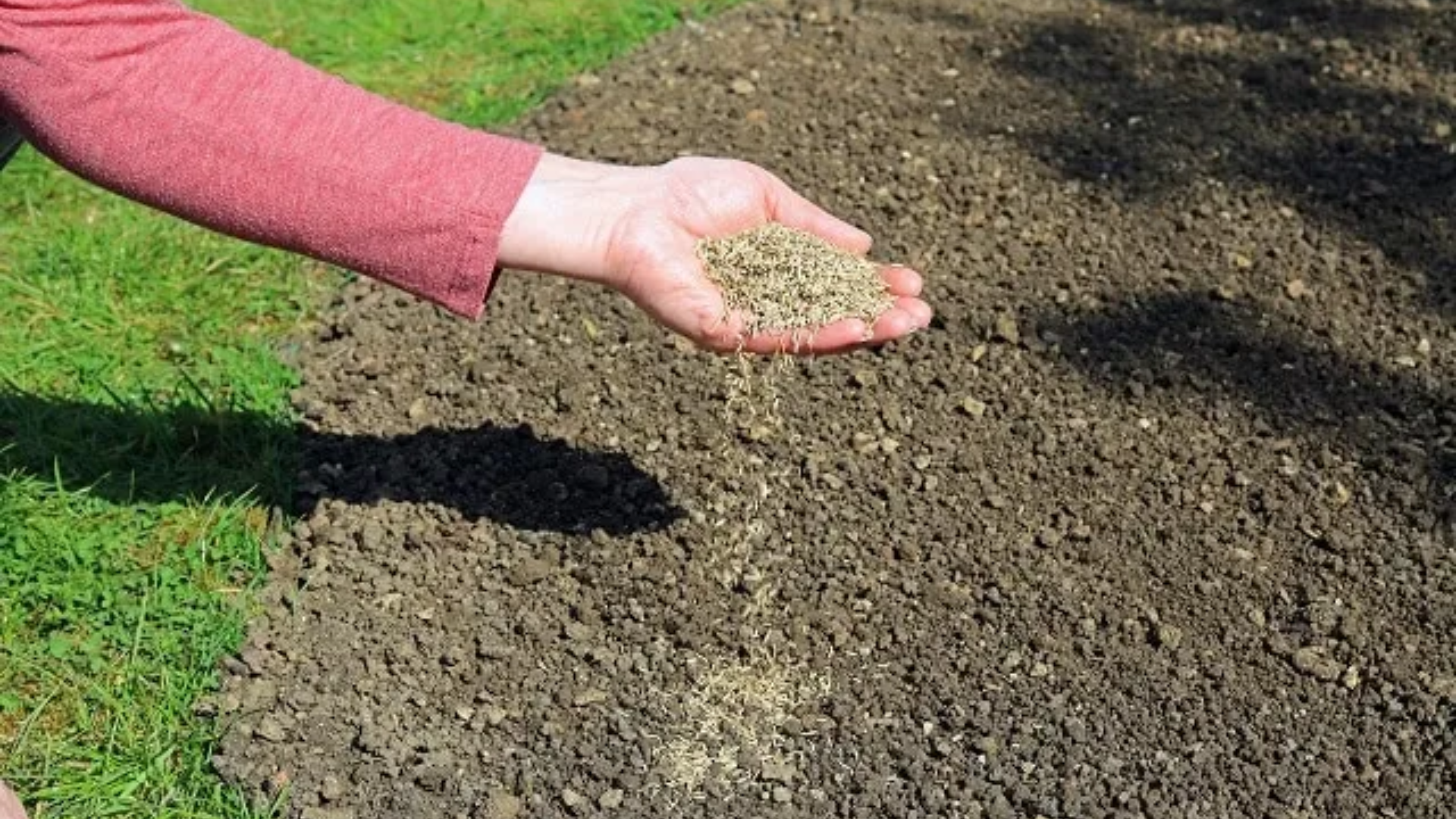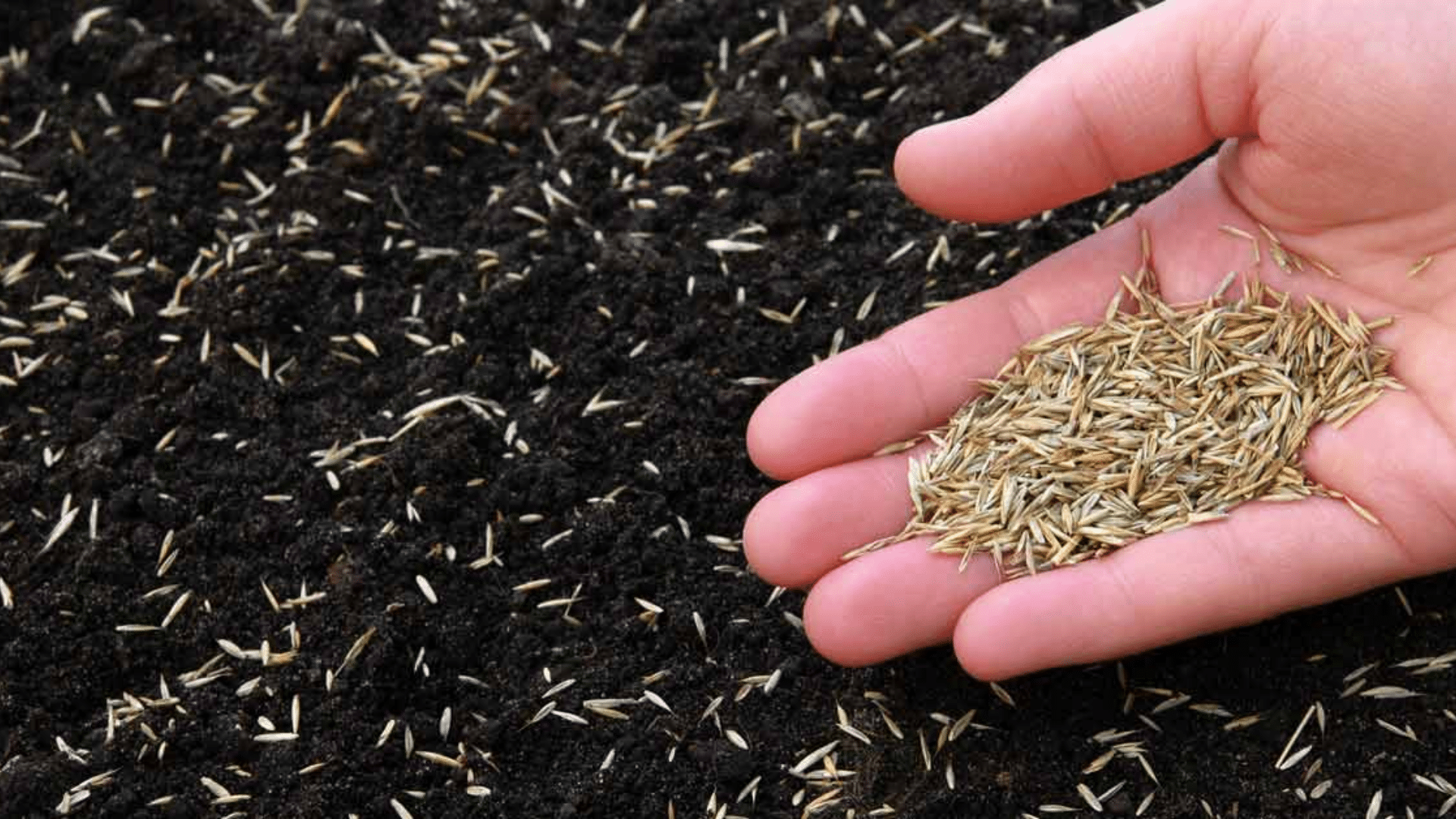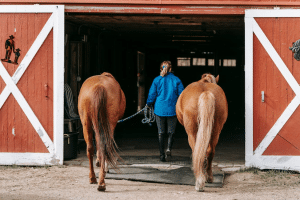A lawn full of patchy spots can make your yard look tired. Many people search for a fast way to fix it. One of the first ideas that comes to mind is grabbing a bag of seeds and simply spreading it over the grass. But does that really work?
It sounds easy. Just sprinkle, water, and wait. But grass doesn’t grow well without the right setup. Although this method appears to be quick, it often yields poor results. The seeds may not reach the soil. They could dry out on top, get washed away by rain, or be picked off by birds.
This blog addresses the primary question: Can you simply sprinkle grass seed on your lawn? We’ll discuss what happens when you do, why it might fail, and how to give those seeds a better chance to thrive.
If you’re hoping for fuller grass that fills in thin spots, taking a few extra steps can lead to stronger, more lasting results.
Can You Just Sprinkle Grass Seed on Your Lawn?

Yes, you can sprinkle grass seed directly on your lawn. Many people do it because it’s fast and requires minimal effort. You just shake the bag, spread the seed, and hope for the best.
It’s easy to see why this method is popular. It saves time, and there’s no need for tools or extra steps. For someone with a busy schedule or a few bare spots, it feels like a quick fix.
But the truth is, this method often doesn’t work well. Most seeds won’t grow unless they come into contact with the soil. They may sit on top of grass, thatch, or dry areas and never sprout. Some might blow away or get eaten by birds.
While you can sprinkle seeds, don’t expect thick, healthy grass unless you prepare the lawn first. A little extra care before and after spreading the seed gives you a significantly better chance of having a green, full yard.
When Sprinkling Grass Seed Works Best
I’ve learned that sometimes just sprinkling grass seed really can work, but only in the right conditions. At first, I didn’t think much about it. I thought the seed would grow no matter what. But after trying a few times, I started to notice what made a big difference. A quick look at the times when sprinkling seed actually worked well for me:
| Condition | Why It Helps Sprinkled Seed Grow |
|---|---|
| Thin Lawn (Not Bare) | Existing grass helps protect new seed and keeps soil in place. |
| Good Soil Contact | Seeds that touch the soil can root better and grow faster. |
| Moist Ground | Damp soil keeps seeds from drying out and helps them sprout. |
| Mild Temperatures | Cool nights and warm days create perfect conditions for germination. |
| Low Foot Traffic Areas | Less walking means seeds aren’t crushed or disturbed. |
| After Light Raking | Raking helps seeds settle into the soil instead of sitting on top. |
| With Frequent Watering | Watering daily keeps the topsoil moist, which is key for seed growth. |
| Using High-Quality Seed | Better seeds sprout quicker and grow thicker with less effort. |
| Best Seasons: Spring or Fall | These seasons offer mild temps and more rain, perfect for new seed. |
When these things lined up, I saw great results without doing much extra work. It made the process easy and stress-free. So now, before sprinkling seeds, I make sure at least a few of these conditions are in place. It saves time and helps the grass grow faster and thicker.
How to Prepare Your Lawn Before Sprinkling Grass Seed
If you want the seed to grow well, the lawn needs to be prepared first. This helps the seed make contact with the soil and remain in place.
- Mowing the lawn: Start by mowing your lawn shorter than usual. This creates space for the new seed, allowing it to reach the soil.
- Rake or scarify the surface: This clears out old grass and loosens the top layer, which helps the seed settle in better.
- Clear the debris: Clear any leaves, sticks, or clumps of dead grass. This allows more light and air to reach the soil.
- Soil breakage: If your soil feels hard in some areas, break it up gently. This improves drainage and facilitates root growth.
With a few simple steps, your lawn will be ready to support new seed and healthy development.
Step-By-Step Guide to Overseeding the Right Way
Overseeding can help fill in bare spots, improve lawn thickness, and restore your yard’s health. But to get the best results, you need to follow a few key steps. These steps help the new seed grow strong and blend with the existing grass.
- Select the right grass seed: Choose a seed that matches your existing grass type and grows well in your local climate.
- Mow and rake: Cut your lawn short and rake to remove dead grass, leaves, and thatch.
- Aerate if needed: If the soil is packed down, poke small holes to help air and water reach deeper.
- Spread seed evenly: Use a seed spreader to cover the lawn with a steady, even layer of seed.
- Water gently and frequently: Keep the soil moist, but not saturated. Light watering once or twice a day helps seeds sprout.
Following these steps gives your lawn the best chance to grow thicker, stronger, and healthier without wasting time or seed.
Tips to Boost Germination Success
Once you’ve spread the seed, the work isn’t done. The next few days are crucial for growth. Taking simple steps after seeding helps protect the seed, keep it moist, and improve the chances of a full, healthy lawn.
- Apply a thin layer of topsoil or compost after seeding: This helps cover the seeds and retains moisture, preventing them from drying out.
- Cover lightly with straw or seed mat to protect from birds: A thin cover hides the seed and helps it stay in place.
- Avoid mowing until new grass is 3 inches tall: If you mow too early, you risk tearing up the roots before they’re strong enough.
- Avoid foot traffic: Stay off the lawn until the new grass is tall and rooted. This helps protect the young plants.
These small steps can make a big difference in how well your lawn fills in – the better care you give early on, the better the results.
Mistakes to Avoid When Seeding a Lawn

Seeding a lawn can be easy, but a few wrong moves can lead to poor results. It’s common to think grass will grow no matter what, but missing even one step can make the whole process fail.
Avoiding these mistakes can help you get better results with less effort.
- Skipping soil prep: Without loosening the soil or clearing old grass, the seed won’t take root.
- Using too much or too little seed: Too much seed can crowd the space, while too little leaves gaps that weeds may fill.
- Choosing the wrong seed type: If the seed doesn’t match your lawn’s needs or climate, it may not grow well at all.
Planning and giving the seed a good start leads to a healthier lawn in the long run.
When to Try a More Complete Lawn Repair?
Sometimes, sprinkling seeds isn’t enough. If your lawn has large, bare areas or is thinning all over, it may require more than just a few quick steps. A full renovation is the better choice if the lawn is mostly dead or has deep problems below the surface.
If the soil is compacted and feels hard all over, the seeds won’t reach deep enough to grow well. In this case, aerating the lawn and adding topsoil can help. If you’ve tried seeding before and it didn’t work, it’s time to change the approach.
More care and better tools may be needed. Additionally, consider a full repair if the area has issues with shade, pests, or water accumulation. These issues prevent grass from growing, even if you reseed. In these cases, taking the time to repair the lawn yields better, longer-lasting results.
Conclusion
Spreading grass seed by hand sounds simple, and it can work, but only if done right. If you skip key steps, most of those seeds won’t grow. They need more than water. Seeds have to touch the soil to sprout. If they land on old grass or dead stuff, they can’t settle or root.
I found this out after tossing seed on my lawn without prepping anything. Hardly any of it grew. Later, I took time to rake, mow, and loosen the soil, and saw a big difference.
Even small steps like clearing debris and keeping the area damp can help new grass grow stronger.
So yes, sprinkle grass seed, but don’t stop there. Prep the area, water it right, and stay consistent. A little care goes a long way toward a better lawn.














91 Responses
Best time is when the rain comes. It’s nothing like rain water. That’s what the farmers depended upon back in the day. My mother, when she was alive use to catch rain water for her plants.
How do you keep rabbits 🐇 from my grass and plants
Can I apply Weed & Feed at the same time? If not, when should I spread grass seed? Also should I dampen yard or wait until I spread grass seed… Then dampen?
Thank you,
Isabelle
I live in phx. Az. N don’t have any luck with grass. The people we pay to do our grass put in winter n summer grass n all we have is weeds now.. we are tried of paying people to do yard work n grass work n all we have is weeds.
You live in a very hot, dry climate. Unless you water every day for newly seeded grass, and three times a week during times of no rain, it won’t grow. Maybe ask a nursery about native drought resistant ground covers?
Soil test. (Many areas offer free testing via the local co-op agricultural office. Testing is often free most of the year minus a few months/peak season for professional farmers. Which is often before anyone rise thinks about planting anything.
As far as the weeds go the easiest way to get rid of them is to get rid of everything and start over with new seed (or sod if you want to go that route). If they are spread all over getting them our of the lawn can be a challenge.
One thing that might help either way if you’re doing bare spots or the entire lawn is pre-germinating your grass seed. If you do that make sure to weigh the seed and mark that weight on something kept with it for each bag you are doing. (It’s a good idea to have an area in mind for each of these bags to cover.) You will not be able to weigh it or know how much you are spreading after if you don’t do this. You will also need a carrier to spread the seed. (Unless you can get it dried out enough to spread it quickly.) I think most of the things you will find will give the same one, but you can also mix it with soil products like garden soil, compost, top soil, etc, just make sure whatever you use will work with the grass you are using. Mixing it with soil works good for bare spots, but it could be dumped over other areas and spread out with a rake. I just haven’t done that, so I can’t say how well it works in my area. It should work well for both bare spots & thin sections of grass.)
Thank you, thank you👌👌needed to know.
Excellent instruction & friendly read…thank you!🙂
100% can jist throw seed out n let it go. ppl like to make things more complicayed than it is lmao. its weird
Buy a 100 lb bag. Sooner or later something will happen.
I’ve tried your way a few times. Doesn’t work. When I raked the soil and used top soil, then watered frequently, it finally grew.
Hey Randy, not to be a complete prick, but I would have to say that your information is incorrect. Or at least doesn’t apply to ALL grass seeds because I spent $6 on a bag of grass seed from the Dollar Store in DFW…. just poked holes in the bag, and slung the stuff all over my badly damaged yard. Didn’t even water it. Within a week, it was probably pretty close to an inch tall!
Now, for the point of my argument…. Since I had just carelessly slung the bag all over the place and didn’t water any of it (meaning with a hose, but I think it did rain once or twice), imagine my surprise when I moved a box off of my concrete porch to discover a patchy strip of 3 or 4 inch-long grass had been growing on my concrete- no soil! This kinda defeated everything I THOUGHT that I knew about how stuff works in the garden (which isn’t much), but, just thought I’d share. I haven’t done anything with it, so it should still be there… maybe I’ll take a pic or 2.
Wet ground. Hard rake or Light with a lot of pressure. Move soil a little. Throw seed. Period.
I have a good bit of grass growing on the concrete floor of my garage. It looks great. Better than the rest of what was planted. I think it was some of the seed I had pre-germinated. So it had some water then, but it didn’t really have any while it grew to be the 2″ height I found it at & i didn’t think that was enough for it to look extremely healthy like it did. (It may have gotten some of it rained heavy due to minor leaking in the garage. But, it’s only a few places that I’m not sure even would go where the grass was/is. I also don’t remember getting much rain at all, so the floor probably didn’t leak.)
As far as concrete and grass goes, I find that it’s one of the best spots to grow grass. It will not grow where I plant it in the ground next to my concrete patio. Yet it grows up out of the concrete where I didn’t plan it. I get the wind can blow the seed, but I’ve burn it multiple times with the torch one being a hand torch one being a 500,000 BTU torch grade Roundup on it taking the weed eater and be like gotten it out pulled it out a number of times & it keeps growing up out of the concrete where it was never planted all while not growing out of the soil next to it that I’ve broken up and prepared best I could in attempt to grow said grass. I believe I remember hearing the ground was too hard or something,.So I broke it up really well, but i have to call BS when it seems to thrive in the concrete next to it. I’m 100% sure it’s a lot harder than the dirt next to it that the grass refuses to grow in.
I have access to leaf mulch that I would say looks like a perfect ammendment to add to soil for seeding bare spots or a sparse lawn.
This looks like “black gold”, perfectly broken down leaf mulch. My question is, what would be the percentage mixture of soil to leaf mulch. If I’m using 5 gallon buckets, as example, 1 bucket of leaf mulch to 3 buckets of soil?
Any soil experts have an opinion or know the correct answer?
How are you going to measure the existing soil? (I don’t see you digging it up and putting it in a bucket.)
I think a better approach might be putting a layer on top then working that into the soil. (Like if you have a garden tiller that can go down 8″ then maybe put a 3″ layer on top and start tilling. If you’re doing this then you don’t have to worry about the leafs being broken down into small pieces as they will do that in the process, but you might find using leaf mold (leaves that have set in piles & broken down into compost) work better for that purpose.
Using leafs that have already stated to break down (in the aspect of turning into compost, not in size) means they will break down quicker in the soil. (Idealy the leaf mold will mostly be broken down into compost already.) So those would be the best to use, but using dry leafs will eventually break down and turn into that. So you can use them too.
It’s organic matter, so it should work with either sandy or clay soil. The only problem you might encounter (that i can think of, so make sure there isn’t any other issues) is using leaves that haven’t broken down into compost might take some of the nitrogen out of the soil. (If it does it will release it when they break down which shouldn’t be too long, but depending on the existing nitrogen in the soil you may want to add a little to make up for this.)
I’m not 100% sure how much nitrogen the leaves can soak up (or even if they soak up any at all), but I think they do soak up a little. I believe it’s less than wood & that seems like it would be right, but I’m not sure. So you’ll probably want to check on that. Just know that it is going to release it back in the soil when they break down whatever absorbed it would do that would or whatever so don’t think that it is a permanent thing and don’t let anybody make you think that it is a permanent thing because whatever absorbs it if something exhorts it absorbs it that is an organic material like that it is released back into the soil when the organic material breaks down. (Wood can be buried in the soil of a garden and used to provide water and nitrogen two plants of the garden slowly over time. After an initial period of watering so that it can soak up both water and nitrogen & you may or may not have to add a little nitrogen to make up for what the wood soaks up when you first do this.)
When putting grass seed down you need to cover it with straw.If you don’t the birds will pick it and you won’t get the coverage you normally would. My neighbor who is a lawn expert told me this yrs ago. I did it and it worked great. Once the new grass seeds start to grow you can rake away the straw or leave it and the birds will use it for their nest and houseing.
How much does a seed cost
Better quality seed is more expensive and
will yield better results( i.e.: stay away from bags labled ‘Contractor Mix’). That said, don’t go cheap. Inferior seed generally contains ALOT more weed seed which leads to ALOT more $$$ out of your pocket in the long run in the form of battling the weeds w/ weed killer.
Depends. Better quality seed is pricier which equates to better reults. Personally,
as far as grass seed is concerned, I’ve never gone cheap…..
how can i get rid of moles in my yard? did purchase solar alarms to see if will help. Any suggestions
I have a book of Benjamin Franklin’s Wisdom and I remember it said that when dealing with moles, TO DROP A RAW GARLIC CLOVE IN ITS HOLE! LoL
I don’t have any, but if you try it, let me know if it works. heh
You might have a grub issue. Have you tried
putting down a grub killer 2c if it helps?
I use to have moles and other under ground animals. I put dirty kitty litter down the holes. It worked for me.
Chewing gum will do the trick!
We have the same problem. We just put out Tomcat mole traps and got our 1st one the next morning..it worked pretty well
You have to eliminate the food source so the moles will forage elsewhere. They eat the grubs that are just an inch or two below the grass surface. Good luck.
Pesticide to kill the grubs will have the moles move out.
I luv all this superb advice. I’m in the front yard now patching up my bald spots with seeds. My neighbors will be jealous of my new lawn’s look. I want them to be green with envy. I’ll water the seeds in two hours. Thank you.
Thank you for the info, I just did bald spots on my lawn
Hopefully it will work.
Thank you for the information!! I read somewhere that a 2- 2-1 ratio of topsoil, sand, and compost is also beneficial!!
I live in South Eastern North Carolina and have a lawn of “controlled weeds” called Centipede. Can I over seed the entire lawn with Bermuda seed?
If so, how many years will it take to establish the
lawn and make it respectable? I’m assuming the new seed will dominate the old, Centipede with time.
Thank You
Jim Callahan
Calabash, NC
Why Bermuda? It’s pretty sorry for activities. I’ve always treated it as a pest because it will choke other plants.
I’m near Charlotte and had an infestation of centipede grass. Use Trimec and follow instructions exactly and they will be gone!
Excellent!
Thank you.
Thank you for the professional advice.
What is the best grass to use for a green, thick yard that doesn’t die off and look terrible in the cold, winter months?
Marijuana. Works wonders for me!
Tall or fine Fescue, and perennial rye or a mix of both are the goto all round winners for wayt you describe. They can withstand scorching summers and freezing cold much longer than any other grass, less prone to disease, and required low maintenance. Very drought tolerant and good for areas where there’s lots of foot traffic. And if you start getting dry patches, watering it regularly will bring it back if its one of those summers that hardly rained at all or if to much sun in one spot, but normally it can take the droughts, heat and cold pretty well. You can always try overseeding if the lawn starts to look kinda thin in certain areas. They’re really very forgiving grasses. The rye will grow the fastest, while the fescues may take a little longer. It’s why they make a good pair. They can look similar and while one is dormant, the other will bloom early keeping your lawn looking green longer. 💚
Kentucky Bluegrass is very popular in Iowa. We have hot summers and winter blizzards.
How best to repair dog urine spots and is it safe to allow dogs on lawn after Scott’s Weed and feed or is there a safe red n feed for dog traffic
GM
I have a couple of areas where my grass is very sparse
One area is where a bush is blocking most of the sun. Please Help!
Holy Moses.
Does putting sand down help?
Straw
If you till it it could help but lime is a great soil conditioner as well as using the clay soil conditioner.
I have a 50-pound Goldendoodle, and I’m looking for ways to keep him off the seeded area in my yard. Would it be possible to keep him indoors for two weeks to protect my grass? I’m really eager to restore my beautiful green lawn. I appreciate any advice you can offer, and I plan to try your suggestions today. Thank you!
Best,
Audrey
I have a 120lbs Anatolian Shepard. I had to seed fairly large section of the yard. To keep him off the newly seeded area I got 4-5 foot bamboo stakes/poles, skinny but strong, inexpensive from Walmart. I placed them about 3ft apart from each other around the perimeter and then just ran twine around the poles so he couldn’t go through.
It worked fantasticly and he usually bulldozers over everything. * The bamboo poles come in bundles for about $4. (2025) April 🙂
Thanks
Great content I found it interesting
What hardy grasses thrive on hillsides with
Little care keppingyard green
Thanks for very needed information !
When do you put in the fertilizer?
Right before or right after. No repucussions either way…..
Years ago I had some roof repairs done and the contractor had a dumpster parked on the zoysia lawn. And then a delay of about a week. I covered where the wheels trenched the lawn with newspaper covered with diluted Elmer’s glue sprinkled with fescue seed and put the paper over the damaged areas, (seed side down) and put rocks around the edges. Nine days later, new grass. Watering about every other day. The fescue covered the damaged areas and the zoysia covered it up in one growing season.
Thank you
We live in a Sandy are grass has a hard time getting started.
Just bought 3 bags of Evergreen dwarf grass. It hasn’t come yet. But am hoping to have a lush green lawn soon
Great article!
I add peat moss as the fourth step, (cut, rake, seed) to keep soil moist. ( Southwestern Ontario, Canada)
Did an overseeding in July that took, got a tip of the cap from a couple of golf course superintendents. (I followed their instructions to a tee)
Good accurate details on procedures .
Hope I can pull him up on Sirius Radio…. Im from Northeast Ohio and loves yard work and gardening…thanks, Daddeo
What kind of fertilizer should I put down on the soil before I reseed a bare spot?
“Starter Fertilizer”.
What kind of fertilizer should I put down in the soil before I put the seed down on a bare spots? Is there a code such as 12/12/12?
Very light I always just use manure blend spread thin.
I was just wondering if you have any idea for me
After my new septic tank the yard needs attention and this article was just what I needed. Thank you.
I agree , glad you are getting the word out. :-).
Very good advice.
Thanks for your comments !
I have a combination of Centipeed and St. Augustine in my yard in P. C. Beach and in May I need to seed several area ! What kind of seed will fill in and match the grass that I have now .
Would it be good to Straw it after planting ?
Yes!
Wise and practical decisions based on your intuitive, reality discernment. Well done with a well-developed examination of the presence of truth.
Raking a very small area makes sense…but not if you have an acre or more to sow…what then?
A mower with a power rake attachment. Hire a professional
Use a slit seeder available at most rental yards,no prep and no straw
Sounds like you need to remediation on your soil or better irrigation system
Sow and disk with hay spread over the top to stop birds from eating lunch
If I used to much seed will it still sprout.
Yes.
Love it
😊
You can presprout your seeds before putting them out.
I have 2 large dogs. It is difficult to grow grass. I have used sod and it hasn’t worked.
Any thoughts?
Use artificial fake grass. The good realistic kind and not the plastic astroturf carpet stuff .
The good stuff actually drains snd washes off really nice.
I’m in central Alabama, my yard is shaded that is best seed to plant ?
Fescue works well in shaded areas
Try using common dandelion seed.. grows fast and the flowers are beautiful.
Are you insane. It’s a weed.
Hey Weed is legal in Missouri. 🙃 Marijuana finally doing the most on the Farm.
My thought exactly! I’ve spent hours with a split paper plate and Round Up getting rid of those weeds on my lawn.
😅😂🤣 I see what you did there. I enjoyed your humorous comment.
Thank you
Very good advice on seeding a lawn